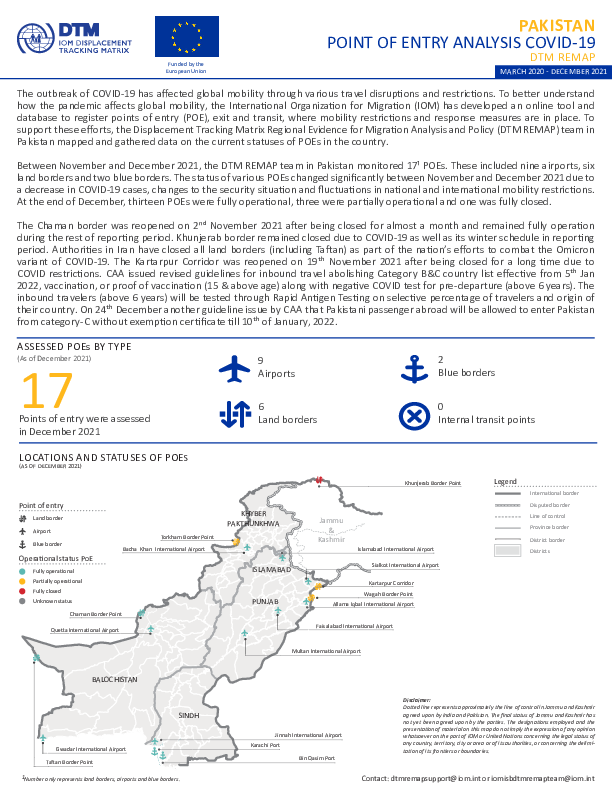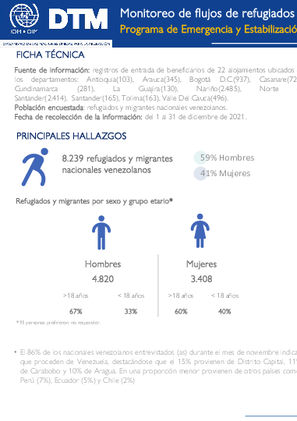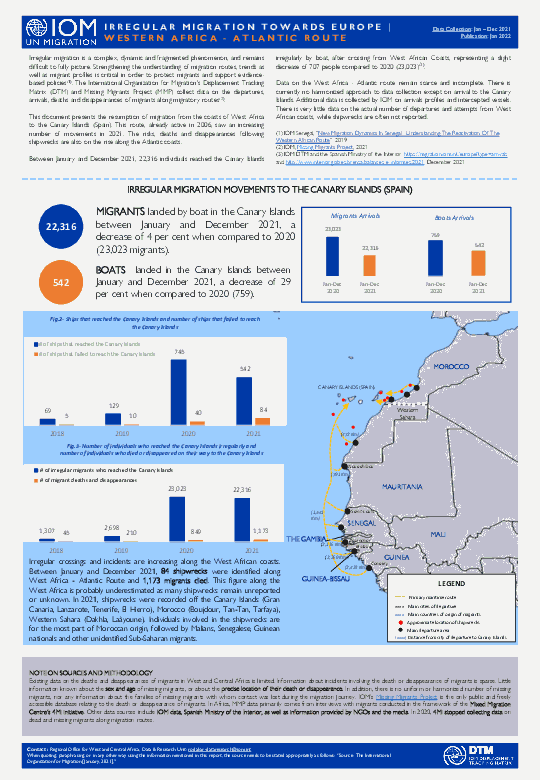-
Countries
-
Data and Analysis
-
Special Focus
-
Crisis Responses

Contact
DTM Mauritania, DTMMauritania@iom.int
Language
French
Location
Mauritania
Snapshot Date
Jan 15 2022
Activity
- Flow Monitoring
- Points of Entry (PoE)
La pandémie de COVID-19 a eu des conséquences majeures sur la mobilité dans le monde. Au-delà des fortes perturbations de la mobilité, de nombreux gouvernements ont imposé des mesures limitants ou interdisant les mouvements de personnes dans le but d'endiguer la propagation du virus. Ainsi, dès le 15 mars 2020, le gouvernement de la République Islamique de Mauritanie a progressivement mis en place des mesures limitant les déplacements dans le pays mais surtout ,les mouvements vers et depuis d'autres pays(fermetures des frontières) pour contenir la propagation de la pandémie. Ces mesures, comme un couvre-feu et des restrictions des voyage, ont été graduellement levées à partir de levées à partir de juillet 2020, décembre 2020 avant d’être remises en place à partir de mars 2021. La dernière mesure a été prise en janvier 2022 avec une reprise de l’interdiction des rassemblements due à la découverte du variant Omicron.
Afin de fournir des informations fiables, l’OIM a développé un outil de collecte de données permettant de cartographier l'emplacement des principaux points d'entrée (PdE) dans le pays, de recueillir des données sur leur statut opérationnel et d'identifier les mesures et les restrictions imposées à ces points. Cet outil utilise la méthodologie de suivi des populations mobiles (DTM) de l’Organisation internationale pour le migrations (OIM). Les évaluations ont pour but d'aider les autorités nationales, les agences des Nations Unies, les organisations et autres parties prenantes clés à identifier et à développer des interventions adéquates de préparation et de réponse à la pandémie au niveau des PdE. Ce rapport quadrimestriel présente des informations sur le statut opérationnel, les mobilités transfrontalières et les mesures préventives mises en place dans 28 PdE à travers le pays.

Contact
iomisbdtmremapteam@iom.int
Language
English
Location
Pakistan
Period Covered
Mar 17 2021
Dec 31 2021
Activity
- Points of Entry (PoE)
The outbreak of COVID-19 has affected global mobility through various travel disruptions and restrictions. To better understand how the pandemic affects global mobility, the International Organization for Migration (IOM) has developed an online tool and database to register points of entry (POE), exit and transit, where mobility restrictions and response measures are in place. To support these efforts, the Displacement Tracking Matrix Regional Evidence for Migration Analysis and Policy (DTM REMAP) team in Pakistan mapped and gathered data on the current statuses of POEs in the country.
Between November and December 2021, the DTM REMAP team in Pakistan monitored 171 POEs. These included nine airports, six land borders and two blue borders. The status of various POEs changed significantly between November and December 2021 due to a decrease in COVID-19 cases, changes to the security situation and fluctuations in national and international mobility restrictions. At the end of December, thirteen POEs were fully operational, three were partially operational and one was fully closed.
The Chaman border was reopened on 2nd November 2021 after being closed for almost a month and remained fully operation during the rest of reporting period. Khunjerab border remained closed due to COVID-19 as well as its winter schedule in reporting period. Authorities in Iran have closed all land borders (including Taftan) as part of the nation’s efforts to combat the Omicron variant of COVID-19. The Kartarpur Corridor was reopened on 19th November 2021 after being closed for a long time due to COVID restrictions. CAA issued revised guidelines for inbound travel abolishing Category B&C country list effective from 5th Jan 2022, vaccination, or proof of vaccination (15 & above age) along with negative COVID test for pre-departure (above 6 years). The inbound travelers (above 6 years) will be tested through Rapid Antigen Testing on selective percentage of travelers and origin of their country. On 24th December another guideline issue by CAA that Pakistani passenger abroad will be allowed to enter Pakistan from category-C without exemption certificate till 10th of January, 2022.

Contact
REMAPBD@iom.int
Language
English
Location
Bangladesh
Period Covered
Mar 17 2021
Dec 31 2021
Activity
- Points of Entry (PoE)
The outbreak of the COVID-19 pandemic at the beginning of 2020 has affected global and regional mobility, including mobility in Bangladesh, through various travel disruptions and restrictions. To better understand how the pandemic affects global mobility, the International Organization for Migration (IOM) developed an online tool and database to register points of entry, exit and transit - such as airports and land and blue border crossing points - where mobility restrictions and preparedness and response measures are in place. To support these efforts, over a period of 22 months, the Displacement Tracking Matrix Regional Evidence for Migration Analysis and Policy (DTM REMAP) team in Bangladesh mapped and gathered data on the locations, statuses and restrictions at Points of Entry (PoE) in the country. The information gathered allows more in-depth analysis to uncover specific trends related to the locations, statuses and restrictions of PoEs in Bangladesh.
In December 2021, the DTM REMAP team in Bangladesh assessed 23 PoEs. The most common type of PoE reported was land borders (12), followed by airports (8) and blue borders (3). Internal transit points are not taken into account for analysis in this snapshot. During the PoE reporting period, the number of assessed PoEs in Bangladesh increased from 19 to 231 PoEs. The status of the PoEs changed notably. None of the PoEs were fully operational at the beginning of the assessment. However, by December 2021, 19 PoEs were fully operational, one was partially operational, three were fully closed.

Contact
DTM Support — iomdrcdtm@iom.int
Language
English
Location
Democratic Republic of the Congo
Period Covered
Dec 21 2021
Dec 23 2021
Activity
- Event Tracking
- Mobility Tracking
L’évaluation rapide de l’OIM (Emergency Tracking Tool, ETT) est un outil mis en place dans le but de collecter des informations sur les mouvements importants et soudains de populations. Ces informations sont collectées à la suite de visites sur le terrain et ou d’entretiens téléphoniques avec les informateurs clés des sites de déplacement ou des communautés d’accueil. D’autres informations sont ensuite recueillies et analysées à partir des outils d’Evaluation Rapide Multisectorielle (ERM). Ce rapport synthétique présente les résultats de l’évaluation menée sur terrain du 21 au 23 décembre 2021.

Contact
DTM Nigeria, AllUsersInDTMNigeria@iom.int
Language
English
Location
Nigeria
Period Covered
Jan 17 2022
Jan 23 2022
Activity
- Event Tracking
- Mobility Tracking
Between the 17th and 23rd of January 2022, a total of 3,409 movements were recorded in Adamawa and Borno States. The recorded movements consisted of 3,072 arrivals and 337 departures. Arrivals were recorded at locations in Askira/Uba, Bama, Biu, Damboa, Gwoza, Kala/Balge, Monguno and Ngala Local Government Areas (LGAs) of the most conflict-affected Borno State and in Fufore, Girei, Gombi, Hong, Lamurde, Maiha, Michika, Mubi South, Song, Yola North and Yola South LGAs of Adamawa State.
Departures were recorded in Konduga LGA of Borno, and Fufore, Gombi, Hong, Lamurde, Maiha, Mubi South, Song, and Yola South LGAs of Adamawa State.
Irregular migration is a complex, dynamic and fragmented phenomenon, and remains difficult to fully picture. Strengthening the understanding of migration routes, trends as well as migrant profiles is critical in order to protect migrants and support evidence-based policies. The International Organization for Migration's Displacement Tracking Matrix (DTM) and Missing Migrants Project (MMP) collect data on the departures, arrivals, deaths and disappearances of migrants along migratory routes.
This document presents the resumption of migration from the coasts of West Africa to the Canary Islands (Spain). This route, already active in 2006, saw an increasing number of movements in 2021. The risks, deaths and disappearances following shipwrecks are also on the rise along the Atlantic coasts.
Between January and December 2021, 22,316 individuals reached the Canary Islands irregularly by boat, after crossing from West African Coasts, representing a slight decrease of 707 people compared to 2020 (23,023)

Contact
DTM Colombia, DTMColombia@iom.int
Language
English
Location
Colombia
Period Covered
Dec 01 2021
Dec 31 2021
Activity
- Flow Monitoring
El 86% de los nacionales venezolanos entrevistados (as) durante el mes de noviembre indican que proceden de Venezuela, destacándose que el 15% provienen de Distrito Capital, 11% de Carabobo y 10% de Aragua. En una proporción menor provienen de otros países como: Perú (7%), Ecuador (5%) y Chile (2%).

Contact
RO Dakar, RODakar-DataResearch@iom.int
Language
English
Location
Sierra Leone
Period Covered
Oct 12 2021
Oct 22 2021
Activity
- Other
- Survey
- Flow Monitoring Survey
- Flow Monitoring
The emergence and spread of COVID-19 in Sierra Leone has highlighted the need for effective disease prevention and mitigating measures as well as ordered and structured border management. To that end, it was deemed crucial to garner a better and more comprehensive understanding of mobility patterns and trends, characteristics of mobility and to identify key crossing points with Guinea and Liberia, Sierra Leone’s neighbouring countries.
The International Organization for Migration (IOM)’s Displacement Tracking Matrix (DTM) conducted a participatory mapping exercise between 12 and 22 October 2021 in Kailahun, Pujehun and Falaba Districts, chosen for their strategic location in transboundary mobility, with the aim of identifying major crossing points between Sierra Leone, Guinea and Liberia, understanding mobility patterns and trends, and identifying key characteristics of cross-border mobility. This is particularly important given the porousness of international borders, which make it more difficult to track movements between countries. This exercise sought, by enhancing comprehension of cross-border mobility, to inform programmes and policies to strengthen infection disease preparedness, monitoring and response.

Contact
DTM Mozambique, DTMMozambique@iom.int
Language
English
Location
Mozambique
Period Covered
Nov 03 2021
Nov 25 2021
Activity
- Site Assessment
- Mobility Tracking
From 3 to 25 November 2021, in close coordination with provincial government and INGD partners, the International Organization for Migration (IOM)’s Displacement Tracking Matrix (DTM) teams conducted Multi-Sectoral Location Assessments (MSLA) in 66 sites hosting 194,837 internally displaced persons (IDPs) in Cabo Delgado province, 1 site with 6,567 IDPs in Nampula province, and 2 sites with 285 IDPs in Niassa province, in response to the mass displacements caused by the insecurity situation in the north. In all sites, the majority of IDPs were displaced by the insecurity situation. Of the total 201,689 individuals in the assessed sites, 49,955 (or 25%) are women, 38,546 (19%) are men, and 113,188 (56%) are children.

Contact
DTM Mozambique, DTMMozambique@iom.int
Language
English
Location
Mozambique
Period Covered
Oct 18 2021
Nov 05 2021
Activity
- Mobility Tracking
O aumento dos incidentes de segurança no norte de Moçambique desde 2017 resultou no deslocamento da população, bem como nas subsequentes necessidades humanitárias. Para melhor compreender o alcance das tendências e necessidades das populações deslocadas, a Organização Internacional para as Migrações (OIM) activou a DTM na província de Cabo Delgado em Fevereiro de 2019.
A DTM tem pontos focais e enumeradores em 277 localidades da província de Cabo Delgado e recolhe dados em estreita coordenação com o Governo. Esta 14ª ronda de avaliação abrangeu também as províncias vizinhas de Inhambane (2 localidades, contra 6 reportadas na ronda anterior; a diminuição foi atribuída à realocação) Nampula (53 localidades), Niassa (14 localidades), assim como as províncias da Zambézia (6 localidades), e Sofala (2 localidades).
